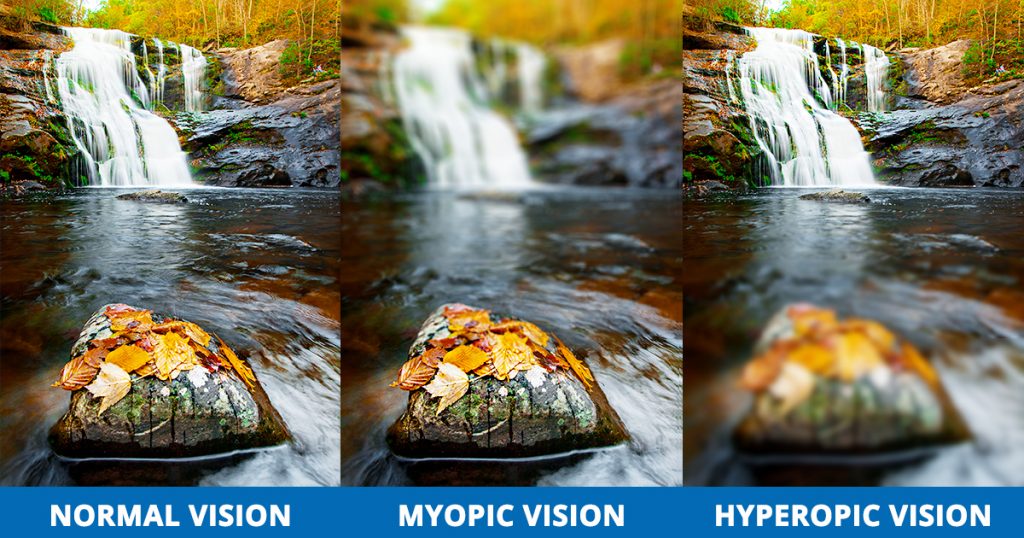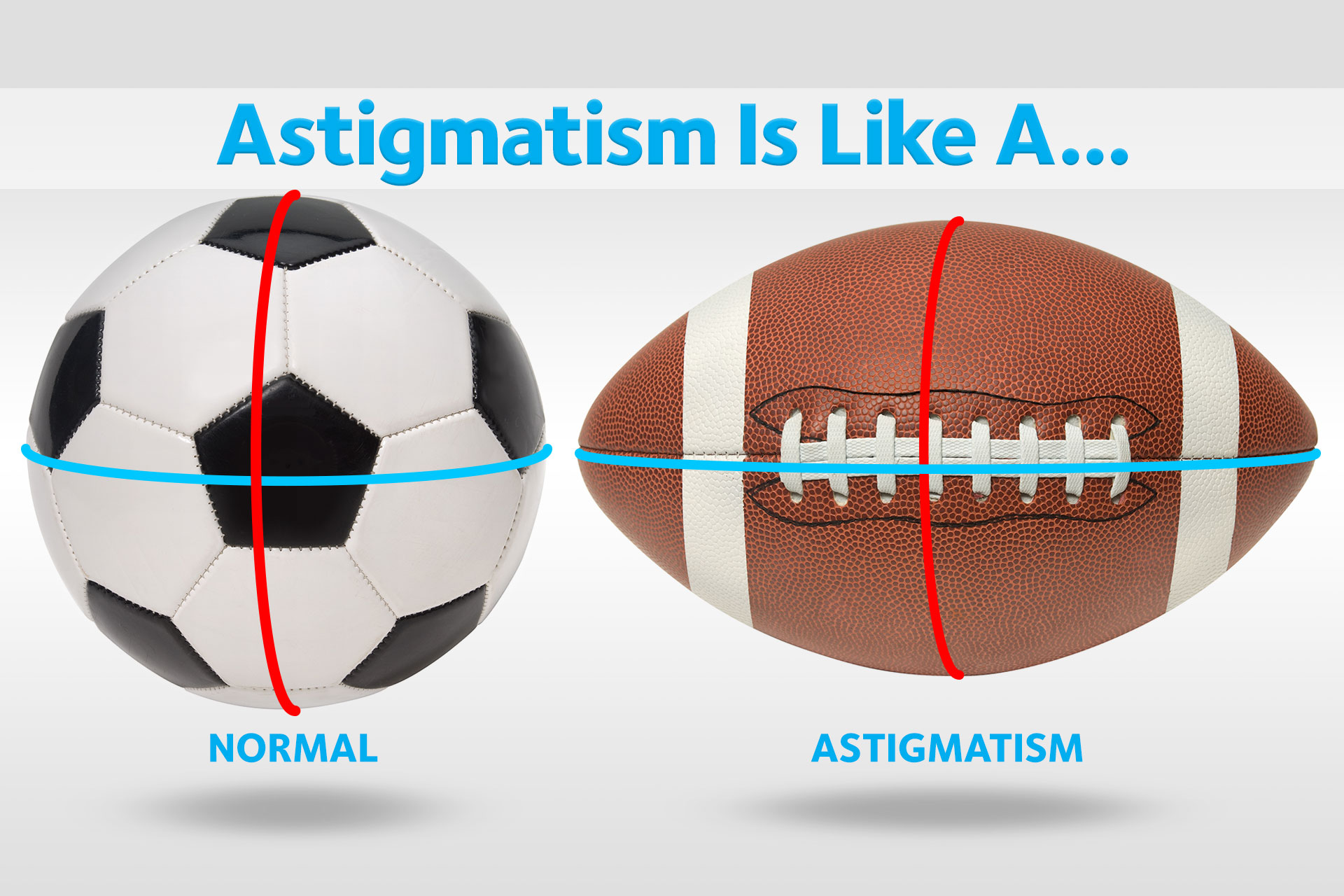You have probably heard it before, whether from your friend or doctor, “Ugh, my nearsightedness got worse this year!” or “You need glasses because of your astigmatism.” But what do these terms actually mean? When you hear these terms from your doctor, they are referring to your refractive error, more simply, the amount to which your eyesight is “off” from being perfect. The higher your refractive error, the greater your need for glasses, contacts, or laser eye surgery.
Nearsightedness can be understood when you think of the word within the term. NEARsighted, meaning objects that are up close, or NEAR, can be seen clearly. But alternatively, if you are nearsighted, the distance will be blurry. So, for a person with nearsightedness, they can see up close clearly, while anything in the distance is fuzzy without their glasses. The medical term for nearsightedness is myopia. You may have heard the sayings, “Don’t be so myopic” or “I think that is a myopic point of view”. Meaning, someone is being “nearsighted” and missing the bigger picture in front of them. Understanding that figure of speech may be a good trick to remembering the term as well.
Farsightedness is exactly the opposite, with a catch (but we will get to that in a second). FARsighted, meaning objects in the distance, or FAR off, are clear. However, if you are farsighted, reading or near vision can be blurry. The medical term for farsightedness is hyperopia. Now, unlike nearsightedness, there are times a farsighted person can see both distance and near, clearly. How is this possible? Remember that catch I said was coming? Well, the eye has muscles and a natural lens that can change our focusing point. Simply, if you are farsighted, you can use your eye muscles, to change the shape of the lens in your eye, to make what would have been blurry up close, clear.
Let’s try a quick analogy to better understand this concept:
Say, hypothetically, we are talking about the “perfect eye,” with perfect vision, which means zero prescription or refractive error. Remember that term from earlier?
Now to understand farsightedness better, let’s talk about how much it would “cost” the eye muscles in order to see clearly (cost meaning how much effort it takes them to see clearly).
So, the “perfect eye,” with no refractive error, is looking at a street sign wayyyyyy down the road. It would take the eye muscles ZERO dollars to bring the sign into focus – meaning it would be completely free and effortless to read the sign. Now, with that same “perfect eye” looking at your iPhone (so you can see your neighbor’s recent post about their dog’s birthday party), it would “cost” the eye muscles $2.50 to view the post –meaning, even with the perfect eye, the eye muscles must work a little to see up close. Ever wonder why your eyes feel tired after working on your computer all day? That’s why. It is completely healthy and normal for your eye muscles to work throughout the day and they shouldn’t have an issue reading for this “perfect eye,” until it gets in its 40’s (gasp)! We’ll explain why that is a little later.
Moving on with our analogy…
Let’s say our eye is no longer “perfect,” but it is now FARsighted or hyperopic. And let’s say at your last doctor’s visit, your prescription was +2.00 in both eyes. So now with our farsighted eye, we are looking at a street sign wayyyyy down the road. For the farsighted eye to see the sign clearly, it will cost the eye muscles $2.00 to read. But what about up close? Remember, even for the “perfect eye,” it will cost us $2.50 to see up close. Well, for our farsighted example, we must add the cost! So now, to read your neighbor’s post about their dog’s birthday party, it will cost the eye muscles $2.00+$2.50 (so $4.50) to read clearly. You can see how the more farsighted you are, the higher the cost of seeing up close, and at some point, your eye muscles are not strong enough to do it (or can’t sustain it) throughout the day.
This is how it is possible for farsighted folks to function without glasses, to some extent, but also why they can suffer from headaches, eyestrain, and even double vision from trying to compensate for an uncorrected prescription.
I hear the nearsighted person shouting from the back of the room, “Wait, why can’t I use my eye muscles to see in the distance?” Sorry, but it only works one direction. Without going into too much detail, eye muscles can only shift the image forward. Being nearsighted, your image is already too far forward in front of the retina. Nearsighted individuals must rely on glasses, contacts, or refractive surgery to bring the distance into focus.
Now, what about astigmatism? Astigmatism is a type of refractive error, which comes from your cornea being shaped like a football, instead of a basketball. This means it is not perfectly round, instead, it has a different curve steepness, up and down, and side to side. This causes your vision to be blurry because the two different curves are causing two different focal points. If you have astigmatism, your doctor will prescribe a prescription with three values, instead of just one.
Example prescription for a patient with astigmatism: +2.00-2.00×180
Example prescription for a patient without astigmatism: +2.00 sph
Do you see the additional two values in the prescription with astigmatism (-2.00 and 180)? These values apply the correction to the astigmatism portion of the refractive error.
Lastly, have you ever wondered why, in your 40’s, you need to hold the menu farther away, or you’re having to enlarge the text size on your iPhone to see it clearly? This is due to the unfortunate effects of presbyopia. Our natural lens begins to harden as we enter into our 40’s and continues to harden, until it has little, to no flexibility left. The lens’ flexibility is what gives us our ability to change focus from distance to near.
Remember our farsighted example? With the lens hardened, and unable to change shape, it can’t bring the menu into focus, unless it’s held out far enough to see. Fortunately, bifocals were invented to help with this problem. I know, I said the dreaded B-word. But take heart – they make no-line bifocals, and even bifocal contacts, to help obtain your specific needs without the unwanted “look” of typical bifocals. Also, it’s important to remember, this happens to everyone, eventually. It does not mean your eyes are “bad”. It is just a normal age changing process that we all get to look forward to.













